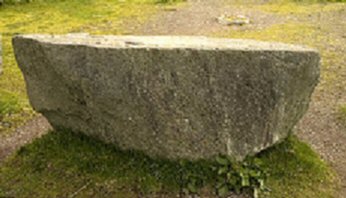Drombeg is one
of the finest of a unique series of stone circles which were built in
the Cork/Kerry region during the Bronze age (c. 2,000 - 900 BC)
(1)
The circle consists of symmetrically arranged
stones with the two tallest or 'Portal stones' to the north-east
forming an entrance, and the lowest to the south-west called the Recumbent or
Axial stone. The number of stones in the circles of
this region can vary from 5 - 19; there are 17 at Drombeg.

Of the original 17 pillars of smooth-sided local sandstone erected in a
circle of 9.5m (31ft) in diameter, only 13 remain. To the left of the
north-east entrance is a portal stone 2.2m (7ft 2in) high; its opposite is
the 1.9m (6ft 10in) long recumbent which has two egg-shaped cup-marks (one
with a ring around it).
Excavations
in 1957 and 1958 revealed cremated bones in a deliberately broken pot
wrapped with thick cloth and buried near the centre of the circle along with
80 other smashed sherds, four bits of a shale and a collection of sweepings
from a pyre (recalling similar deposits at the Scottish recumbent circle of Loanhead of Daviot).
The excavation of Drombeg by Fahy (JCHAS 1959)
revealed that the entire inner area of the circle was covered with a
gravelled floor layer up to 10cm thick.
About 40m (44yds) to the west
of the circle are the remains of two stone-built prehistoric huts joined by
a common doorway. The smaller has a cooking place 1.5 x 1.1m (5ft x 3ft 6in)
on its eastern side; this was still in use in the 5th century AD. This
prehistoric kitchen had a flagged trough in which water was boiled by
dropping red-hot stones into it. Recent tests confirmed that using this
method, 70 or more gallons of water could be boiled in almost three hours.
 Astronomy:
Astronomy:
The stones
were shaped to slope upwards
to the recumbent itself. The midpoint of this stone was set in line with the
winter solstice sunset as viewed in a notch in the distant hills;
the alignment is good but not precise.
On the perfectly flat upper
surface of the recumbent stone (right), are two shallow depressions
(cup-marks), one surrounded by an oval carving.
(Archaeoastronomy)
(Recumbent Stone Circles)
(Other
Irish Sites)
(Index
of Ancient Sites)
(A-Z
Site Index)